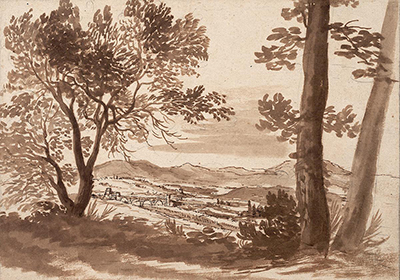Nicolas Poussin was a highly skilled draughtsman who produced endless numbers of study drawings in preparation for his complex painted compositions. Most were never finished, but experimented with different variants of the same theme.
This was an artist who obsessed about his paintings, and would want every element of each composition considered down to the last detail prior to starting the overall artwork. His religious and historically themed paintings would have many, many figures right across the canvas, and each one would be planned individually on paper. He did not trust his studio in quite the same way as other artists at this time, too, so would only feel comfortable in doing each and every stage of the development himself rather than passing off some of the stages to others. The example included in this page was completed in pencil, pen and brush with black and brown wash - it is titled View of the Tiber Valley with the Ponte Molle and is owned by the Albertina Museum. Their collection also includes drawings by Michelangelo, Bruegel and Durer.
This French artist produced most of his work in Italy, often travelling around the countryside, capturing scenes in his notebooks. This was ideally suited to drawing, or the practice of simple washes of colour which can be found in most of his sketches. That technique was similar to his later paintings, and so could more easily be translated from one to another. His interest in, and promotion of, landscape painting as a genre in its own right was matched only by Carracci and Lorrain up to that point, before the mass influx of the Impressionists and Romanticists later on. His figurative work also benefited from this continual practice, just as the masters of the Renaissance had done centuries earlier, including Michelangelo, Leonardo da Vinci and Raphael.
That said, Poussin was an artist who took much inspiration for his work from the past. He would have likely studied the masters' drawings at some point, just as he had their frescoes. Recent examinations of his artistic development have suggested that Titian and Raphael were the most similar to his, of those who starred in the Renaissance era, and so it is likely that he would have spent the most time admiring their work over the others. Some critics have argued that he was more in line with Titian initally, before progressing "further" towards the precise compositions of Raphael. Below all of this great work was his substantial talent as a draughtsman, which also helped him to layout a piece prior to starting. Many elements used by the great masters that impress experts would not be picked up by the fleeting follower of art, such as certain elements of symbolism or certain technical approaches.
Poussin is known to have sketched many antiquities within the city of Rome during his extended time there. He also paid great attention to the Raphael Rooms in the Vatican. It was a great priviledge to have some of the finest art in European history as accessible as it was to him then. It would be harder for an artist to get such access today to such high profile pieces. Those knowledgable in the techniques of drawing and painting have studied his sketches in detail and concluded that his signature approach was the use of sensitive touches of the brush, accompanied by equally delicate shading from colour washes which added an element of three-dimensionality to these scenes.




